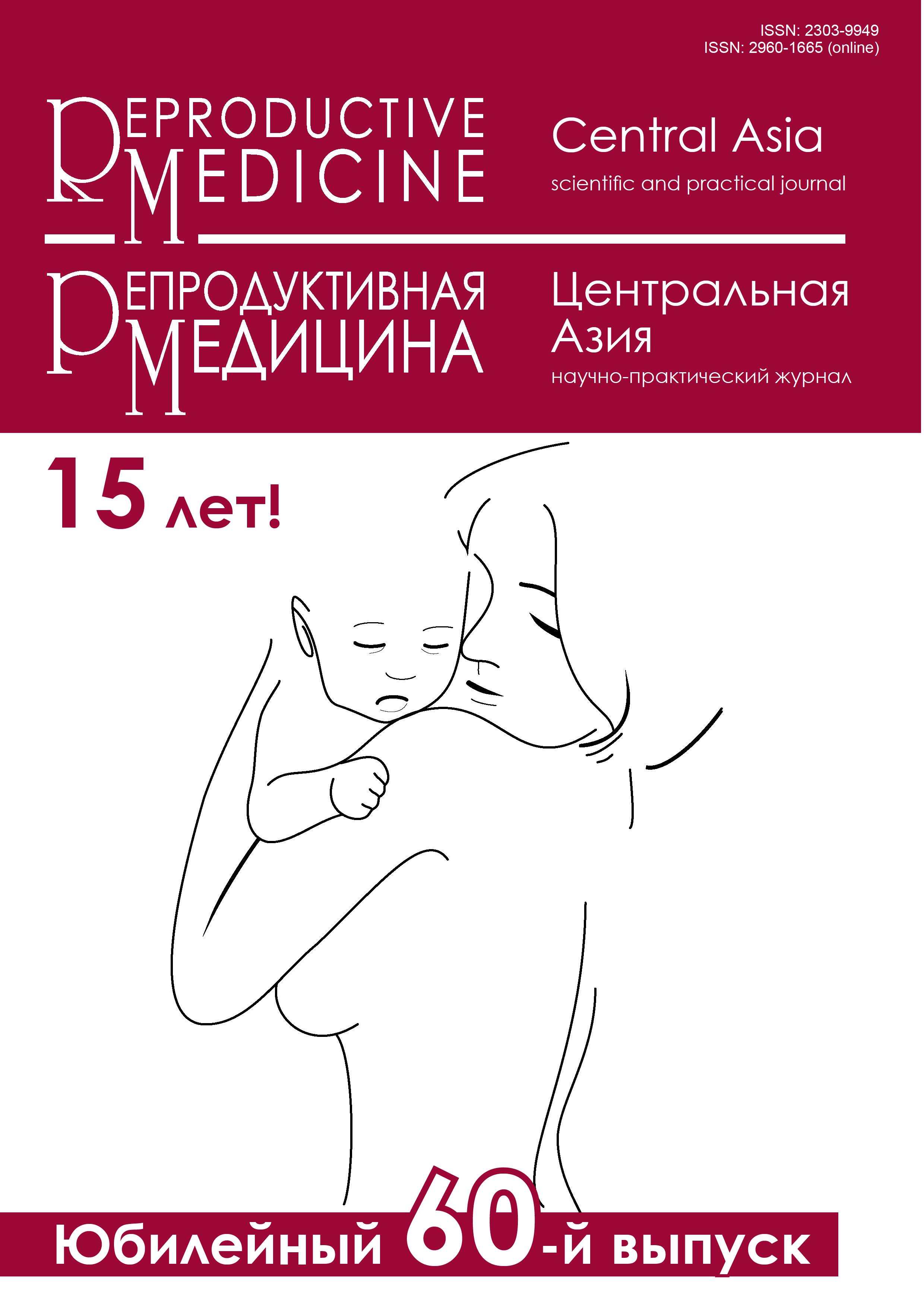Evaluation of coagulogram parameters for predicting early pregnancy loss
DOI:
https://doi.org/10.37800/RM.3.2024.82-91Keywords:
blood clotting factors, blood clotting disorders, early pregnancy loss, thrombosis factorsAbstract
Relevance: To date, there are conflicting data regarding the diagnostic value of coagulogram results and the number of platelets for repeated screening for miscarriage among the general population of women of reproductive age. Thus, in this study, we sought to assess the prognostic potential of existing coagulogram and platelet screening tests in predicting hemorheological disorders associated with early pregnancy loss.
The study aimed to study the prognostic value of coagulation parameters about the outcomes of reproductive losses.
Materials and methods: This retrospective case-control study included 215 women of reproductive age who were divided into two groups: the main group (n=127) consisted of those who had reproductive losses and had two or more adverse pregnancy outcomes during up to 13 weeks of pregnancy; the control group (n=88) consisted of healthy pregnant women who had no history of adverse pregnancy outcomes during up to 13 weeks of pregnancy. A comparative analysis of the listed laboratory parameters of coagulogram and platelet count in these groups was conducted using the nonparametric Mann-Whitney U–test. Logistic regression analysis was used to predict adverse pregnancy outcomes.
Results: In predicting adverse pregnancy outcomes in clinical practice, the use of statistically significant parameters (fibrinogen, platelets) led to a 63.26% probability of reproductive failure. Using coagulogram parameters in the logistic regression model (χ2=10.637; p=0.10030) to predict the risk of reproductive failure showed the probability of reproductive loss of 62.33%. These indicators of reproductive loss did not differ significantly. Coagulogram indicators have a low prognostic potential for predicting adverse pregnancy outcomes based on violations of the body’s blood clotting constants.
Conclusion: The use of laboratory coagulogram parameters (activated partial thromboplastin time, prothrombin time, international normalized ratio, and prothrombin index) and platelet count had no prognostic value about the outcomes of reproductive losses.
References
European Society of Human Reproduction and Embryology Early Pregnancy Guideline Development Group. Recurrent Pregnancy Loss: Guideline of the European Society of Human Reproduction and Embryology. 2022;3.
Garrido-Gimenez C, Alijotas-Reig J. Recurrent miscarriage: causes, evaluation and management. Postgrad Med J. 2015;91(1073):151-162.
https://doi.org/10.1136/postgradmedj-2014-132672
Sekiya A, Hayashi T, Kadohira Y. Thrombosis prediction based on reference ranges of coagulation-related markers in different stages of pregnancy. Clin Appl Thrombosis/Hemostasis. 2017;23(7):844-850.
https://doi.org/10.1177/1076029616673732
Grossman KB, Arya R, Peixoto AB, Akolekar R, Staboulidou I, Nicolaides KH. Maternal and pregnancy characteristics affect plasma fibrin monomer complexes and D-dimer reference ranges for venous thromboembolism in pregnancy. Am J Obstet Gynecol. 2016;215(4):466.e1-466.e8.
https://doi.org/10.1016/j.ajog.2016.05.013
Hwang KR, Choi YM, Kim JJ, Lee SK, Yang KM, Paik EC, Jeong HJ, Jun JK, Yoon SH, Hong MA. Methylenetetrahydrofolate reductase polymorphisms and risk of recurrent pregnancy loss: A case-control study. J Korean Med Sci. 2017;32(12):2029.
https://doi.org/10.3346/jkms.2017.32.12.2029
Alijotas-Reig J, Palacio-Garcia C, Llurba E, Vilardell-Tarres M. Cell-derived microparticles and vascular pregnancy complications: a systematic and comprehensive review. Fertil Steril. 2013;99(2):441-449.
https://doi.org/10.1016/j.fertnstert.2012.10.009
Ticconi C, Pietropolli A, Specchia M, Nicastri E, Chiaramonte C, Piccione E, Scambia G, Di Simone N. Pregnancy-related complications in women with recurrent pregnancy loss: a prospective cohort study. J Clin Med. 2020;9(9):2833.
https://doi.org/10.3390/jcm9092833
Gong JM, Shen Y, He YX. Reference intervals of routine coagulation assays during the pregnancy and puerperium period. J Clin Lab Anal. 2016;30(6):913-917.
https://doi.org/10.1002/jcla.21956
Cui C, Yang S, Zhang J, Wang G, Huang S, Li A, Zhang Y, Qiao R. Trimester-specific coagulation and anticoagulation reference intervals for healthy pregnancy. Thrombosis Res. 2017;156:82-86.
https://doi.org/10.1016/j.thromres.2017.05.021
Wang W, Long K, Deng F, Ye W, Zhang P, Chen X, Dong W, Zheng P, Zhang X, Yang T, Chen W, Yang K. Changes in levels of coagulation parameters in different trimesters among Chinese pregnant women. J Clin Lab Anal. 2021;35(4):e23724.
https://doi.org/10.1002/jcla.23724
Struble E, Harrouk W, DeFelice A, Tesfamariam B. Nonclinical aspects of venous thrombosis in pregnancy. Birth Defect Res C. 2015;105:190-200.
https://doi.org/10.1002/bdrc.21111
Refaai MA, Riley P, Mardovina T, Bell PD. The clinical significance of fibrin monomers. Thrombosis and Haemostasis. 2018;118(11):1856-1866.
https://doi.org/10.1055/s-0038-1673684
Jiang L, Du Y, Lu Y, Wu X, Tong X. Monitoring of hemostatic parameters for early prediction of first-trimester miscarriage. Biomarkers. 2021;26(6):532-538.
https://doi.org/10.1080/1354750X.2021.1933592
Fu M, Liu J, Xing J. Reference intervals for coagulation parameters in non-pregnant and pregnant women. Sci Rep. 2022;12(1):1519.
https://doi.org/10.1038/s41598-022-05429-y
Lava C, Udumudi A. Genetic markers for inherited thrombophilia related pregnancy loss and implantation failure in Indian population–implications for diagnosis and clinical management. J Maternal-Fetal Neonatal Med. 2022;9:1-9.
https://doi.org/10.1080/14767058.2022.2038560
Armstrong EM, Bellone JM, Hornsby LB, Treadway S, Phillippe HM. Pregnancy-related venous thromboembolism. J Pharm Pract. 2014;27(3):243-252.
https://doi.org/10.1177/0897190014530425
Kevane B, Donnelly J, D'Alton M, Cooley S, Preston RJ, Ní Ainle F. Risk factors for pregnancy-associated venous thromboembolism: a review. J Perinatal Med. 2014;42(4):205-207.
https://doi.org/10.1515/jpm-2013-0207
Bates SM, Middeldorp S, Rodger M, James AH, Greer I. Guidance for the treatment and prevention of obstetric-associated venous thromboembolism. J Thrombosis and Thrombolysis. 2016;41(1):92-128.
https://doi.org/10.1007/s11239-015-1309-0
Akin MN, Kasap B, Yuvaci HU, Turhan N. Association between platelet indices and first trimester miscarriage. Blood Coagul Fibrinol. 2016;27(5):526-530.
https://doi.org/10.1097/MBC.0000000000000445
Ali A, Mohan P, Kareem H, Muhammed MK. Elevated factor VIII levels and shortened APTT in recurrent abortions. J Clin Diagnost Res. 2016;10(1):EC04-EC06.
https://doi.org/10.7860/JCDR/2016/17841.7080
Yang Y, Hu Y, Wu M, Xiang Z. Changes of new coagulation markers in healthy pregnant women and establishment of reference intervals in Changsha. J Central South Univ Med Sci. 2022;47(4):469-478.
https://doi.org/10.11817/j.issn.1672-7347.2022.210536
Зубков Д., Тайжанова Д., Амирбекова Ж., Турдунова Г., Беспалова Н. Информативность скринингового обследования параметров коагуляции для прогнозирования раннего выкидыша: обзор литературы. Реп мед (Центральная Азия). 2022;4(53):55–62.
Zubkov D, Tayzhanova D, Amirbekova Zh, Turdunova G, Bespalova N. The informativeness of screening examination of coagulation parameters for predicting early miscarriage: A literature review. Reprod med (Tsentralnaya Aziya). 2022;4(53):55–62. (in Russ.)
Downloads
Published
How to Cite
Issue
Section
License
Copyright (c) 2024 The rights to a manuscript accepted for publication are transferred to the Journal Publisher. When reprinting all or part of the material, the author must refer to the primary publication in this journal.

This work is licensed under a Creative Commons Attribution-NonCommercial-NoDerivatives 4.0 International License.
The articles published in this Journal are licensed under the CC BY-NC-ND 4.0 (Creative Commons Attribution – Non-Commercial – No Derivatives 4.0 International) license, which provides for their non-commercial use only. Under this license, users have the right to copy and distribute the material in copyright but are not permitted to modify or use it for commercial purposes. Full details on the licensing are available at https://creativecommons.org/licenses/by-nc-nd/4.0/.




